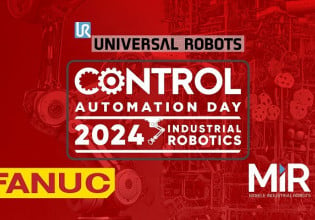Comau and Leonardo Pilot Automated Inspection for Helicopter Blades
Robot manufacturer Comau has joined forces with Leonardo, an aerospace and defense manufacturer, to develop an intelligent robotic inspection system for helicopter blades up to seven meters long.
Comau is a well-established robot manufacturer who, for the better part of fifty years, has been developing industrial robots that can be integrated into virtually any industry. Leonardo is an aerospace and defense manufacturer. The two companies have piloted an autonomous robotic inspection system for helicopter blades. The plan is to develop a smart solution that can provide a complete inspection with both tapping tests and visual inspections for blades measuring up to seven meters in length.

Comau and Leonardo’s smart solution performs automated inspection of helicopter blades up to seven meters in length. Image used courtesy of Comau
End-to-End Inspection
Vision systems provide robots with sight so they can detect obstacles and perform inspections. The greatest advantage of a robot having sight is the ability to plan its path. A programmer typically determines a robot’s path with a series of points. The program will then command the robot to the points in succession.
Comau and Leonardo’s robotic solution uses vision systems to learn about its environment. When the operator initiates the inspection, the solution first detects the helicopter blades and any obstacles it needs to avoid. Then, it determines the most efficient path along the blade.
Along with path planning, the system performs a multispectral surface inspection of the blade and provides measurements to determine structural integrity. It then uses thousands of inspection points along its path to perform a high-granular inspection.

The automated inspection solution seeks to bring greater accuracy and efficiency to the inspection of critical aerospace structures like helicopter blades. Image used courtesy of Leonardo
A Robotic Solution
As the robotic solution creates its path, it also reports its efficiency and inspection data. After the path planning process, the robot calculates a cycle time, which can be used to calculate the system's overall efficiency. The system also contains a data acquisition system that records sound responses from the tapping tests and images captured from the multispectral camera.
Comau has taken a no-code programming approach to an advanced, complex AI-driven robotic inspection system, using a platform similar to that found with collaborative robots. Preprogrammed functions such as "look for blade" or "execute action" are easily selected from a user interface. Once the operator mounts the robot arm on the blade, specific tests can be chosen without writing any code. This simple user interface allows shorter training cycles and faster changeover to other blade types.

For the last year, Comau and Leonardo’s robotic inspection system was piloted at a site in Anagni, Italy. Image used courtesy of Leonardo
Advanced Automated Inspection
The autonomous inspection system has been used at the Anagni, Italy, assembly plant over the past year. To further the project, Leonardo and Comau will move the project to another facility to test enhanced functionality such as maintenance, repair, and overhaul services. The system aims to save operators from labor-intensive, repetitive tasks and allow them to upgrade their skills without compromising safety.
This project benefits both parties. Comau will have developed a proven, advanced robotic system that can detect obstacles and create robot paths on the fly. Leonardo will have a tool to perform a 100% inspection of its blades without compromising operator fatigue or safety.






